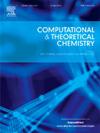Theoretical investigation of organic dyes for dye-sensitized solar cell applications: effect of auxiliary acceptor groups
IF 3
3区 化学
Q3 CHEMISTRY, PHYSICAL
引用次数: 0
Abstract
Using density functional theory (DFT) and time-dependent density functional theory (TD-DFT), the efficiency of a series of novel organic D-π-A-π-A dyes with different auxiliary acceptors in dye-sensitized solar cells (DSSCs) was predicted. The geometrical structures, electronic and optical properties and some key parameters related to energy conversion efficiency, such as light harvesting efficiency (LHE), electron injection driving force (ΔGinject), electron regeneration energy (ΔGreg) and excitation lifetime (τ) of all the investigated dyes were determined and discussed. In addition, dye/(TiO2)9 systems were also studied. The results show that all the dyes substituted by auxiliary acceptors (QL3–1 to QL3–5) have a very narrow energy gap, resulting in a broad UV–Vis absorption spectrum and a red shift in wavelength compared with the reference dye QL3. Among the dyes, QL3–4 and QL3–5 have a remarkably narrow energy gap, a significant red shift in peak wavelength (λmax), a longer excited lifetime (τ) and a large dipole moment μnormal that will produce a higher open circuit voltage (VOC). This indicates that the organic dyes QL3–4 and QL3–5 are suitable dyes for improving the overall energy conversion performance of DSSCs.

染料敏化太阳能电池中有机染料应用的理论研究:辅助受体基团的影响
利用密度泛函理论(DFT)和时间相关密度泛函理论(TD-DFT),预测了一系列具有不同辅助受体的新型有机D-π-A-π-A染料在染料敏化太阳能电池(DSSCs)中的效率。测定并讨论了所研究染料的几何结构、电子和光学性质以及与能量转换效率相关的一些关键参数,如光收集效率(LHE)、电子注入驱动力(ΔGinject)、电子再生能(ΔGreg)和激发寿命(τ)。此外,还对染料/(TiO2)9体系进行了研究。结果表明:与参比染料QL3相比,辅助受体取代的染料(QL3 - 1 ~ QL3 - 5)具有非常窄的能隙,具有较宽的紫外-可见吸收光谱和波长红移。其中,QL3-4和QL3-5的能隙非常窄,峰值波长(λmax)红移明显,激发寿命(τ)较长,偶极矩μ法向较大,从而产生较高的开路电压(VOC)。这表明有机染料QL3-4和QL3-5是提高DSSCs整体能量转换性能的合适染料。
本文章由计算机程序翻译,如有差异,请以英文原文为准。
求助全文
约1分钟内获得全文
求助全文
来源期刊

Computational and Theoretical Chemistry
CHEMISTRY, PHYSICAL-
CiteScore
4.20
自引率
10.70%
发文量
331
审稿时长
31 days
期刊介绍:
Computational and Theoretical Chemistry publishes high quality, original reports of significance in computational and theoretical chemistry including those that deal with problems of structure, properties, energetics, weak interactions, reaction mechanisms, catalysis, and reaction rates involving atoms, molecules, clusters, surfaces, and bulk matter.
 求助内容:
求助内容: 应助结果提醒方式:
应助结果提醒方式:


